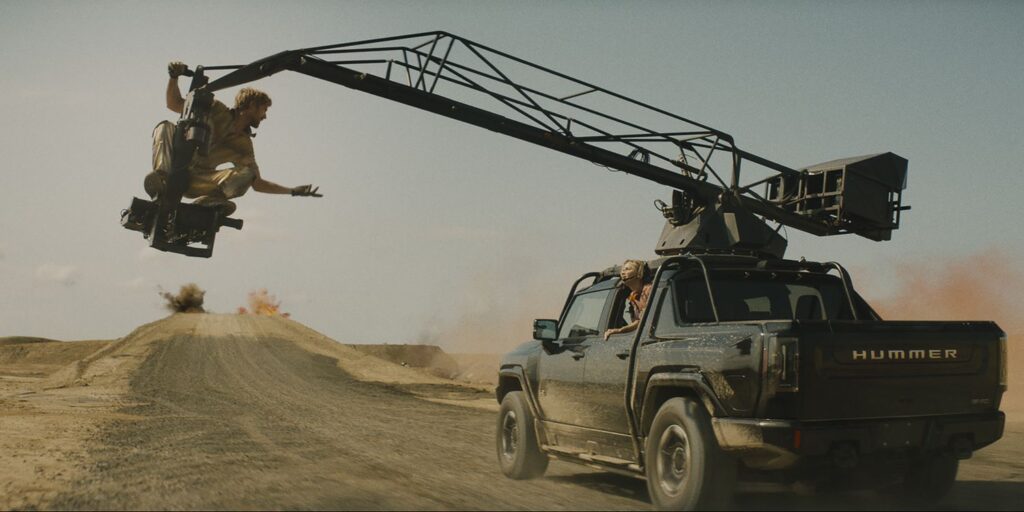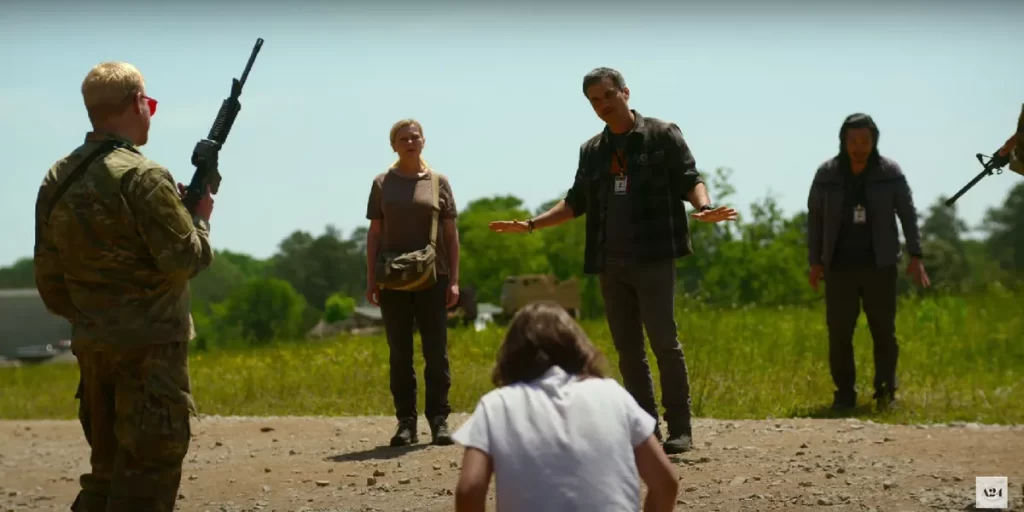By Alex McPherson
11 Honorable Mentions: “No Other Land,” “Nickel Boys,” “A Real Pain,” “The Outrun,” “Monkey Man,” “Love Lies Bleeding,” “Furiosa: A Mad Max Saga,” “Nosferatu,” “Sing Sing,” “In Our Day,” “Ryuichi Sakamoto: Opus”
10. “Good One”
Meditative, and maintaining an undercurrent of suspense throughout, director India Donaldson’s debut feature is a true gem – an indie that has ample layers to unpack beneath its deceptively simple premise. Lily Collias gives one of the year’s absolute best performances as Sam, a young woman preparing to leave home for college, who goes on a weekend backpacking trip with her father, Chris (James Le Gros), and his best friend Matt (Danny McCarthy), in the Catskills. All is not well, however, and tensions simmer among the group; everyone is trying to find their place in the world, navigating life’s complexities. Mesmerizing cinematography from Wilson Cameron and a soothing score from Celia Hollander complement this unconventional and thoughtful coming-of-age story.

9. “I Saw the TV Glow”
Director Jane Schoenbrun’s dreamlike, unnerving, and uncompromising take on identity and loneliness is one of 2024’s most memorable films. It’s difficult to describe and suffused with a foreboding, hypnotically engaging mood. “I Saw the TV Glow” feels like a film of the moment, zeroing in on the ways media and pop culture can help form/support one’s sense of self, and the suffocating effects of not living one’s truth. Open to interpretation and polarizing in the best ways, Schoenbrun once again proves themself as a director with a surreal vision that’s all their own.
8. “Civil War”
Director Alex Garland’s “Civil War” is a provocative look at a dystopian near-future taken to extremes, and a thought-provoking exploration of the nature of journalism and storytelling itself. Looking beyond the film’s grimly compelling Road-Trip-From-Hell structure, excellent performances, and controversial premise that bends some logic, Garland spotlights photojournalists willing to risk their lives and their sanity for the next shot, the next story, in the hopes that, in the end, it will all mean something. It ultimately encourages viewers to look outside the frame to apply their sacrifice to our own reality. Will we merely let their stories wash over us, desensitized, or will we mobilize to support causes that might, one day, end self-perpetuating cycles of violence and cruelty? “Civil War” is an action-packed, grimly entertaining watch on its own, but it’s also a cautionary tale with real bite, a call to action within visceral, propulsive genre filmmaking.

7. “Hard Truths”
Marianne Jean-Baptiste gives a staggering performance in director Mike Leigh’s “Hard Truths,” — a study on empathy, mental illness, existential angst, and community that offers no easy answers. Leigh’s film is alternately funny, shocking, and heartbreaking, as we observe Jean-Baptiste’s character, Pansy, rampaging through every interaction with little consideration for others or for herself. “Hard Truths” is far from an easy watch, often harsh and unrelenting, but there’s great power in seeing shreds of hope shine through at the most unlikely times, something to hold onto if we have the will and bravery to cherish them in the hopes of a brighter future. An essential film.
6. “The Substance”
Coralie Fargeat’s “The Substance” is one of the most intense films I’ve experienced this year — brazenly confident in its style, performances, and satire that’s both in-your-face and ingeniously layered. It’s a poignant takedown of societal beauty standards, especially in Hollywood, but also a nightmarish exploration of fame, self-hatred, and aging bodies. The film’s body horror set pieces are both highly entertaining and wildly unsettling, delivering an escalating series of WTF moments along with human truth and real directorial craftsmanship. Indeed, “The Substance” is an unforgettable ride.
5. “The Seed of the Sacred Fig”
Filmed in secret in Iran, director Mohammad Rasoulof’s “The Seed of the Sacred Fig” is a daring look at a family in disarray. Iman (Missagh Zareh) is appointed as an investigating judge in Tehran’s Revolutionary Court, a sought-after position that nevertheless requires him to sacrifice his personal morality. His responsibilities create a rift between him, his wife, and his daughters, who watch protests outside their home (Rasoulof shows real-life, harrowing footage taken from smartphone cameras) in horror and want to stand up for what they believe in. What follows is an urgent, riveting thriller that reaches a fever-pitch of intensity by its conclusion, made all the more powerful by the bravery of the cast and crew, who risked their lives to bring this story to life.

4. “Do Not Expect Too Much from the End of the World”
Director Radu Jude’s latest film is a blisteringly funny satire that tackles a whole bunch of ideas— worker exploitation, the search for true self-expression, the perils of the gig economy, corporate dehumanization, the push-pull between truth and fiction in filmmaking, and Romania’s tumultuous history — in a nearly three-hour odyssey that’s constantly upending expectations and remains as deeply poignant as it is defiantly unsubtle. Ilinca Manolache is a force of nature as Angela, a production assistant pushed to her limits on a never-ending assignment filming auditions for a multinational company throughout Bucharest, taking breaks whenever she can to make TikToks as her caricatured alter ego, Bobiță. “Do Not Expect,” in all its acerbic glory, is a cry from the heart, a masterful takedown of societal ills.
3. “Wallace and Gromit: Vengeance Most Fowl”
As a lifelong fan of “Wallace and Gromit,” especially “The Wrong Trousers,” my expectations were sky high for the return of the world’s favorite inventor and his canine companion. Luckily, directors Nick Park and Merlin Crossingham do not disappoint — delivering another charming, clever, and well-crafted gem that retains the distinct spirit of the series, putting most other animated films to shame through its sterling attention to detail and all-ages appeal. “Vengeance Most Fowl” packs in some thoughtful commentary about technology (specifically artificial intelligence) as well, and it marks the return of the diabolical penguin Feathers McGraw, one of cinema’s great antagonists. Nothing can recapture the brilliance of the original three shorts, but “Vengeance Most Fowl” comes damn close at times.
2. “Anora”
Fueled by a star-making performance from Mikey Madison, director Sean Baker’s “Anora” is an emotional roller coaster if there ever was one, presenting an intense, darkly comedic, and heartbreaking fairytale turned on its head. With Baker’s characteristically empathetic eye, he explores the complicated nature of the American Dream, the dehumanizing power of wealth, and the perils of young love, while painting compelling pictures of people striving in systems that take advantage of them. Madison, taking us on Ani’s arc every step of the way, expertly conveys the character’s perseverance, fiery spirit, and gradual self-actualization as Baker’s tragicomic odyssey unfolds. A pitch-perfect ensemble elevates the film further, with each character given depth through Baker’s nonjudgmental eye.
1. “Hundreds of Beavers”
There’s some films that change you, and director Mike Cheslik’s “Hundreds of Beavers” is one of those experiences — a slapstick epic that demands to be watched with a crowd. The inventiveness is off-the-charts, and the film is a reminder of the creative potential of the medium, using limited resources and limitless imagination to elicit guffaws galore, while delivering something firmly, unquestionably new. Nothing has stuck with me quite like “Hundreds of Beavers,” and, if you’re one of the hundreds of people I’ve been preaching its merits to who haven’t checked it out yet, consider this all-powerful ranking another nudge to press play. It’s time. Take the plunge.
Alex McPherson is an unabashed pop culture nerd and a member of the St. Louis Film Critics Association.
























